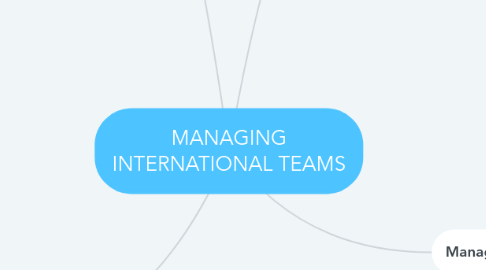
1. Managing cross-cultural diversity
1.1. Frameworks
1.1.1. Hall
1.1.1.1. High context vs low context: time, space, context
1.1.2. Trompenaars
1.1.2.1. universalism/particularism, ind vs coll, neutrality, engagement, statut, orientation
1.1.3. Hofstede
1.1.3.1. cross-cultural communication: power intense, individualism vs collectivism, uncertainty vs avoidance, masculinity vs feminity, LT vs ST orientation
1.1.4. Lewis
1.1.4.1. Behavior: linear-active, multi active, reactive
1.2. Kentucky Fried Chicken Japan
1.3. Working remotely
1.4. Thomas Kilmann conflict mode instrument
1.4.1. Strategies to deal with conflicts
1.4.1.1. Collaboration = The owl
1.4.1.2. Competition= The shark
1.4.1.3. Compromise = the shark
1.4.1.4. Avoid= the turtle
1.4.1.5. Accomodate= the bear
2. Managing cultural differences in negotiation
2.1. Harvard Negotiation Project model
2.1.1. Principled: Separate PEOPLE from problems, focus on INTERESTS not positions, generate possibilities and OPTIONS, insist on an objective standard and CRITERIA
2.1.1.1. Area of common interest and needs = interests (what we want) and needs (what we must have) --> POSITION : no space for dialogue
2.2. Implications cultural differences: communications and negotiations
2.2.1. What does it mean to win= I (individual: USA) vs WE (team: China) ; legally binding agreement (US) vs meet and learn from each other (China)
2.2.2. When we can meet to negotiate
2.2.2.1. Weekends: shabbat
2.2.2.2. holidays: ramadan
2.2.3. Who negotiates
2.2.3.1. position in the company
2.2.3.2. seniority
2.2.3.3. gender
2.2.4. Mix business and pleasure
2.2.5. alcohol
2.2.5.1. islamic countries, US legal constraints
2.2.6. How we communicate
2.2.6.1. High vs low context culture
2.2.6.1.1. explicit vs implicit
2.2.6.2. specific vs ambiguous
2.2.6.3. specific timeline
2.2.6.4. importance of communication outside formal meetings
2.2.7. I/We agree
2.2.7.1. legally binding contract: US
2.2.7.2. good starting point for the next round of negotiations: China
2.2.7.3. I agree but I have to see with my boss
2.2.7.4. We will see further, contracts are secondary: Mexico
2.2.8. Conflict: style of communication
2.2.8.1. Show openly frustration
2.2.8.1.1. Russia
2.2.8.1.2. Tactic to see how others react
2.3. Negotiation models
2.3.1. Win win
2.3.2. Win Lose
2.3.3. 2 parties not willing to accept each others view
2.4. BATNA
2.4.1. Investigation - Determine BATNA - Presentation - Bargaining - Closure
3. Teams for diversity management
3.1. Lost at sea
3.2. Teams: discrete work products through the joint contribution of members= PERFORMANCE = more than the sum of its parts
3.2.1. Small number of people with complementary skills who are committed to a common purpose, set of performance goals, and approach for which they hold themselves mutually accountable
3.2.1.1. ESSENCE= common commitment
3.2.1.1.1. translate if into specific and mesurable performance goals
3.2.1.2. mutual accountability and energy, motivation
3.2.1.3. The new product development game: holistic method as in rugby: the ball get passed within the team as it moves as a unit up the field
3.3. Working groups: working group's performance = what its members do as individuals, sum of all the individual bests of team members
3.4. Right mix of skills: existing skills and potential skills
4. Managing diversity
4.1. Recognizing individual differences
4.1.1. Jung: personality types
4.1.1.1. Attitude types (extrovert, introvert); Functions types (thinking, feeling, sensing, intuition
4.1.1.1.1. MBTI
4.1.2. Kolb: learning styles
4.1.2.1. Learning styles: concrete experience, reflective observation, abstract conceptualization, active experimentation
4.1.2.1.1. Converger
4.1.2.1.2. Diverger
4.1.2.1.3. Assimilator
4.1.2.1.4. Accomodator
4.1.3. Gardner: multiple intelligences
4.1.3.1. interpersonal, intrapersonal, musical, bodily-kinesthetic, spatial, logical-mathematical, linguistic, naturalist
4.2. Team building
4.2.1. establish urgency, demanding performance standards and direction
4.2.2. select members for skill and skill potential, not personality
4.2.3. attention to 1rst meetings and actions
4.2.4. clear rules of behavior
4.2.5. set and seize upon a few immediate performance oriented tasks and goals
4.2.6. challenge the group regularly with fresh acts and info
4.2.7. spend lots of time together
4.2.8. exploit the power of positive feedback , recognition and reward
